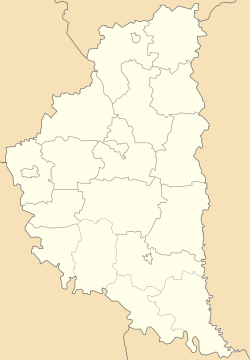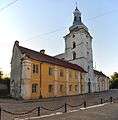Zalishchyky
| Zalishchyky Залiщики | ||
|---|---|---|
 | ||
| ||
 Zalishchyky Location in Ukraine | ||
| Coordinates: 48°39′N 25°44′E / 48.650°N 25.733°E | ||
| Country |
| |
| Oblast | Ternopil | |
| Raion | Zalishchytskyi | |
| First mentioned | 1340 | |
| Government | ||
| • Mayor | Wolodymyr Benewjat | |
| Area | ||
| • Total | 7.16 km2 (2.76 sq mi) | |
| Population (2001) | ||
| • Total | 10,100 | |
| Time zone | EET (UTC+2) | |
| • Summer (DST) | EEST (UTC+3) | |
Zalishchyky (Ukrainian: Залiщики, also Zalishchyky, Polish: Zaleszczyki) is a small city located on the Dniester river in the southern part of the Ternopil Oblast (province), in western Ukraine. It is the administrative center of the Zalishchyky Raion (district).
In 2001, its estimated population was around 10,100.
Geography
Its climate is quite mild with grapes, peaches and other fruits growing in the area. It is especially famous for its tomatoes. Since the inter-war era, it has been a centre for the tourist industry. Before the collapse of the USSR some 10,000 visitors arrived annually. In the interbellum period, the town was an important tourist center of Poland. It is also one of the few wine growing areas[1] in that part of Ukraine.
History
First mentioning of Zalishchyky is traced back to 1340. However the official date of the city establishment is 1766. During 1375–1772 and 1918–1939 Zalishchyky was part of Poland. In 1766 it received the rights of self-government under the Magdeburg Law. During the period 1772–1918 it was ruled by the Habsburg Monarchy (after 1867 Austria-Hungary), with the exception in 1809–1815, when it was under control of the Russian Empire.
For more details see the article Kingdom of Galicia and Lodomeria.
During the 19th century, the area around Zalishchyky was populated primarily by Ukrainian country folk but the town had a large Polish and Jewish population. At the end of the 19th century and the beginning of the 20th century, the area around Zalishchyky witnessed large-scale emigration to the New World, especially western Canada.

After the abdication of the Habsburg Monarchy and the Polish–Ukrainian War of 1918–1919, it again became part of Poland (as part of the Tarnopol Voivodeship), which ruled it until 1939 when it was annexed to Soviet Ukraine (see: Polish September Campaign), a constituent republic of the Soviet Union. Since the 1991 dissolution of the USSR, it is in independent Ukraine.
In the first half of the 18th century, Zalishchyky, known in Polish as Zaleszczyki, belonged to Stanisław Poniatowski, father of Polish–Lithuanian king Stanisław August Poniatowski. In 1766 it officially became a town, with a market square, a parish church in a corner of the square and a grid plan. In 1774, Zalishchyky became the seat of a county in Podole Voivodeship.
In the Second Polish Republic, Zaleszczyki, located in extreme southeast corner of the country, was a very popular spa, called Polish Merano, with sandy beaches located along the Dniester. The town was regarded as the warmest town in Poland and Polish capital of grapevine, with annual Grape Festival, taking place here every summer. Zaleszczyki had a direct rail connection with Warsaw and Gdynia (the distance of 1,314 kilometres (816 miles), the longest route in the Second Polish Republic). Furthermore, a luxtorpeda fast train connected Zalishchyky with Tarnopol.

In 1939, after Soviet capture and occupation of Zaleszczyki (as it was then spelt in Polish), the beaches and orchards were destroyed. The Baroque town hall was demolished, and a monument of Lenin was erected in its spot. The Roman Catholic church of St. Stanislaus was devastated, and turned into a fertilizer storage. The evacuation of all the Polish government and military officials to Romania, following the Invasion of Poland in 1939, did not take place only over the two border bridges in Zaleszczyki (one of which only carried rail traffic, the other only a roadway) but also over a dual (road/rail) bridge near Kuty built in 1930.
On December 1941, Germans sent 200 Jews to labour camps. 800 were forced to the outskirts, where they were murdered in a mass execution. In 2011, a monument was erected near the execution site (at a sports stadium). The proper site of the execution was developed with residential houses and garages after the end of the Second World War. On 20 September 1942, all Jews were moved from the town, mainly to Tłuste. From Tłuste, most of them were shipped to Bełżec extermination camp. Others died during deportations in 1943. Only a few dozen survived.[2]
Archeology and monuments
Before the Second World War, the area around Zalishchyky became a major centre of archeological attention. Near various villages, especially Košylivci (Ukrainian: Кошилівці), a little north of the Dniester, excavations were carried out which uncovered statues, coins, and other artifacts from as far back as the Neolithic Cucuteni-Trypillian culture, and extending through the period of the Roman Empire and the Migration Period in the Early Middle Ages.
Zalishchyky contains a 17th-century Roman Catholic church, an 18th-century Town Hall and other monuments.
Points of interest
- Roman Catholic church of St. Stanislaus, founded by Stanisław August Poniatowski in 1763, and completed in 1828. The church served as a storage in 1946–1992. Currently, it is under renovation,
- the Poniatowski Palace, built in the late 18th century, and remodelled in 1831. It was property of Duke Józef Poniatowski, in the 19th century belonged to the Brunicki family. Its last owners was the Turnau family,
- the Pilsudski Villa, where in 1933 Józef Piłsudski stayed,
- 19th century Roman Catholic cemetery
- the manor house of Jan Kasprowicz, a Polish poet who lived here in 1896–1899.
Gallery
 Church of St. Stanislaus
Church of St. Stanislaus- City park and bridges over Dniester river
 Office buildings in Zalishchyky
Office buildings in Zalishchyky Bruniste Palace
Bruniste Palace
People
- Mykhailo Orest Haivoronsky — a Ukrainian composer, musician, conductor, teacher, violinist, and critic
- Anna Belina – Polish actress
- Leon Biliński – politician and economist, rector of Lviv University
- Mikolaj Hoszowski – scientist and politician, speaker of the Senate of the Free City of Kraków
- Marian Szpakowski – painter
- Carl Gustaf Emil Mannerheim — Marshal and sixth president of Finland was in town during World War I
International relations
Twin towns – Sister cities
Zalischyky is twinned with:
References
- ↑ Reference needed.
- ↑ http://www.sztetl.org.pl/en/article/zaleszczyki/5,history/
- ↑ "Miasta Partnerskie". Bytów City Council Official Site (in Polish). Retrieved 22 June 2013.
- Hryniuk, Stella Peasants with Promise: Ukrainians in Southeastern Galicia 1880–1900 (Edmonton, 1991). Contains a map on the endpapers of the book which shows all of the villages of this part of Galicia, including the Zalishchyky area.
- Przewodnik po Województwie Tarnopolskiem z mapą [Guide to the Ternopil Region with a Map] (Ternopil, 1928: reprinted circa 1990). Contains much historical material.
External links
| Wikimedia Commons has media related to Zalischyky. |
Coordinates: 48°39′N 25°44′E / 48.650°N 25.733°E
